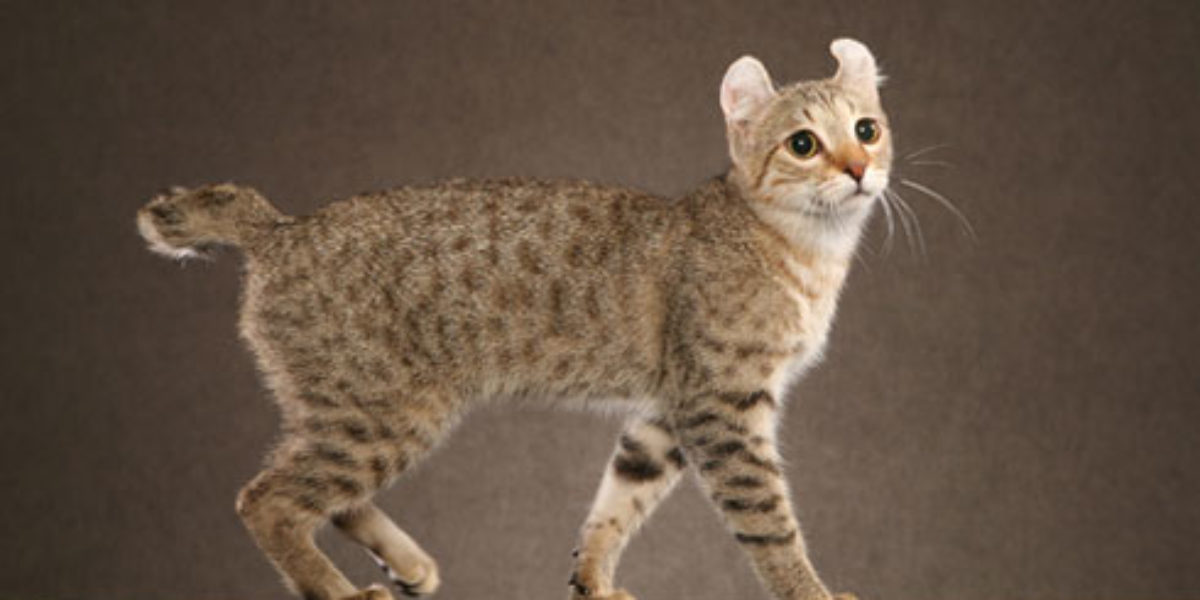Image supplied by Animal Photography
Highlanders, also sometimes known as the Highland Lynx, can be both short haired and long haired and the name refers to the intent of creating a domestic cat with a powerful “big cat”. It has curled tufted ears, a short bobbed tail and often polydactyl feet.
Health and welfare of cats with folded or curled ears
There are several breeds of cat with ears that do not stand up in the normal way – some folding downwards and some curling backwards. The most well known is the Scottish Fold cat where the Scottish Fold gene mutation detrimentally affects cartilage, most obviously seen making the ear cartilage fold (click here for more information). However, the cartilage defect affects their joints as well as the ear cartilage and folds can suffer from severe and painful degenerative joint disease throughout their lives. As the disease progresses the joints stiffen, bones fuse and movement becomes more difficult and extremely painful. Folded or curled ears can also make it difficult for the cat to clean its ears, so owners may need to remove any wax or dirt accumulation from the ear to help prevent discomfort and infection.
We do not have enough information to know whether gene mutations resulting in curled (rather than the folded) ears causes similar problems in cartilage at other sites (such as joints), but there are comments from breeders of these cats that the ears are fragile and may be easily damaged when handled and there is anecdotal mention of narrowed ear canals.
Health and welfare of cats with shortened tails
There is always a strong worry the lack of, or shortened, tail is caused by an inherited deformity of the end of the spine – similar to the Manx cat. There are various different breeds with short tails (stumpy tails), which may be caused by different genetic mutations. The Manx cat’s lack of tail is the result of a genetic mutation that causes severe disease. The true (or ‘rumpy’) Manx has only a small hollow where the tail would have been, although cats with residual (stumpy) tails are also born. The defective gene responsible for the loss of the tail also affects other parts of the spine and may cause severe spinal and/or neurological problems. When two completely tailless Manx cats are mated, the defects may be so severe that many of the offspring may be born dead or die shortly after birth.
The same problems occur in at least some other breeds with short tails, although often there is not a great deal of information on these other breeds. However, with a potential risk of more severe problems, and the lack of a normal tail raises serious questions as to whether breeds should exist which rely on such deformities. Even without further problems, it should be questioned whether deliberately breeding cats without a normal tail is justified and could ever be in the cat’s interest.
Health and welfare issues – other
Polydactyl feet are usually not encouraged as the extra toes can cause problems.
This is another cat put together by using cats with genetic deformities. Where there is potential for harm or welfare problems, we should avoid making breeds.
Important
We have limited the information about inherited disorders to those conditions that are known and proven to exist within a breed. For many breeders and many conditions, insufficient information may be available at this time to know whether any particular breed is necessarily free of any particular condition.
In general, pedigree breeds use a much smaller gene pool for breeding than domestic cats and therefore have a higher risk of developing inherited disorders. In addition, a number of ‘newer’ pedigree breeds are derived from matings between one or more ‘older’ breeds, and in these situations perpetuation of inherited problems that were seen in older breeds is likely within the newer breeds.
Thank you for visiting our website, we hope you have found our information useful.
All our advice is freely accessible to everyone, wherever you are in the world. However, as a charity, we need your support to enable us to keep delivering high quality and up to date information for everyone. Please consider making a contribution, big or small, to keep our content free, accurate and relevant.
Support International Cat Care from as little £3
Thank you.
Donate Now


